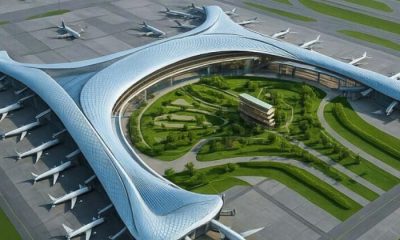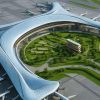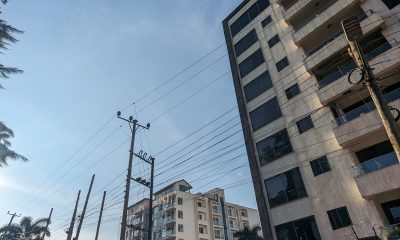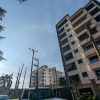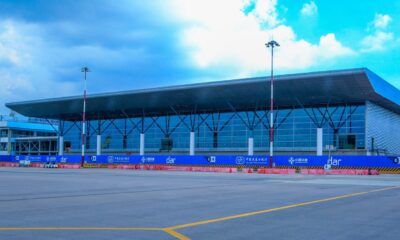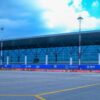Travel
Opportunities arise as CAA adopts new masterplan
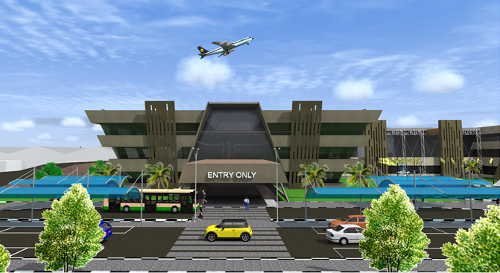
CAA new masterplan shows the design of new terminal
The Uganda Civil Aviation Authority (CAA) has adopted a new 20-year masterplan for Entebbe International Airport that envisages the development of numerous commercial and recreational facilities at the airport to make life more enjoyable for the travelling public.
Ignie Igunduura, takes The Sunrise’s Henry Lutaaya through the Masterplan.
Qn. What is the new masterplan about?
We developed two masterplans to guide the development of the aviation industry for the next twenty years. The first one – the national civil aviation master plan, covers the whole country and focuses on the infrastructural developmentsneeds for the country. The second one is specific to Entebbe – the Entebbe Redevelopment Master plan. These two are now ready and we will be launching them soon.
Qn. CAA has been implementing a masterplan for some years now. What happened to it?
The first masterplan we adopted as an institution was in 2002. That followed a ten-year period of rehabilitation from 1991 to 2001. Following the rehabilitation, we needed to have a master plan to guide the expansion at Entebbe International Airport (EIA). We adopted that 20-year plan in 2002. It was supposed to take us to 2022. But it has been overtaken by developments in the economy. For example, we are currently handling traffic that was supposed to be handled in 2022. This means that traffic has outgrown our projections in that master plan.
Currently there is a shortage of parking space for air craft. We are also experiencing space constraints for passengers. As you may be aware, new airlines have been coming in big time. Now if you are going to be able to meet the demand by service users, you have to develop a new masterplan.
The new masterplan has been developed by a Spanish company known as INECO, and was procured through the International Civil Aviation Organisation (ICAO). They are one of the best in terms of developing masterplans for civil aviation. We have adopted the plans to guide the development of the civil aviation industry in the next twenty years, from 2014 to 2034.
Qn. What do you want to put in place?
Under the Entebbe International Airport Development Master plan, we will see the construction of a modern cargo centre to replace the warehousing facilities we have at the airport. The current facilities we have are not cargo centres but stores that were developed to store coffee in the 1970s.
We plan to expand the passenger terminal southwards. We have gone through the preliminary designs of the new passenger terminal and we are working on the new cargo centre.
The proposed new cargo centre will come with a complete industrial area, which means air craft will come in and be able to park. Trucks will come in, load and offload cargo. The space is going to be massive. We are going to phase the development of the cargo centre in anticipation of the cargo growth that we will be experiencing.
By 2018, we are supposed to be handling 77,100 metric tons of cargo. By the same time, we are also projecting to process 2.3 million passengers annually. By 2033, which will be close to closure of planned period, we are looking at 7.7 million passengers annually, and 172,000 tones of cargo.
Qn. Do you have enough land. You seem to be constrained for land considering that EIA is located on a peninsular.
That is very true. We are terribly constrained for land but we are going to be squeezing all these facilities in the land that we have. We have been crying out for some land and the government has given us a bit of land, but this is not comparable with what our neighbours have.
I will make comparisons; we have been asking for 132 hectares of land. In comparison, Jommo Kenyata has been given an extra 2000 hectares of land, on top of the 5000 hectares they already have. So Kenya has at its disposal 7000 hectares of land, compared to slightly above 120 hectares that we have.
We are dealing with a very small area, but we need to fix whatever we are planning in this area because we have to take care of growth. But there is a long term plan that we’ve asked our government to look at. If Entebbe is going to remain this country’s main gateway, it is going to need more land, which will require relocating people from places within the proximity of the airport, or find an alternative place for the airport. And that is not far from now.
We cannot be able to deceive ourselves. The airport will have to expand as the economy and population grow. Short of this, Entebbe International Airport (EIA) will remain as an airport city to service Entebbe and Kampala.
Qn. Are you planning to invite private players to implement some of the projects?
We are going to co-opt private players in the areas where we think there is enough competence out there. As CAA, we would want to remain in charge of core areas of providing things like aeronautical services – eg air navigation, airport operations and management. What may happen is that we may put up the infrastructure and invite private players to manage some of these facilities.
But in areas where we find there is competence out there, we may invite private players – like we have done for the shopping mall. Part of the plan is to turn EIA into a shopping city with big convention centres. And that involves a lot of things that CAA cannot get into. We are talking about leisure centres, shopping malls etc so that you attract more people to spend longer hours at the airport before you catch your next flight.
Qn. How far have you moved on this?
Yes, we have allocated land. We have also carried out technical studies to ensure that if infrastructure is developed for a shopping mall, and related leisure facilities, it wouldn’t interfere with safety of operations, because that is key. We have already identified a private investor.
Qn. When do you anticipate construction of these facilities to start?
We are still waiting for land use plans. Because of the land problem, you need to see how each plan works with the other. You do not have a shopping mall that is isolated from all the other projects; it will be difficult to operate. We need to know where the modern car-parking facilities are going to be so that they interface directly with the shopping mall. It must also interface with the airport, to ensure that someone can park, shop and fly.
Qn. Besides the new Entebbe Express Highway, what mode of transport are you envisaging within the airport city?
There is a national transport multi-model plan that has been developed by the Ministry of Works. It picks on a number of recommendations that focus specially on evacuation of passengers to and from EIA. The construction of the Entebbe Express Highway is one of the fruits of that plan.
The plan also looks at utilising Lake Victoria as a transport route. You can have a marine service that goes as far as Tororo. It can deliver a lot of people from different stopping points such as Jinja, Luzira and take as many going back. Secondly, we are also thinking of a tram service from Kampala straight to the airport. It will deliver you at the security point so that you start with security checks.
Qn. How much money do you need to implement all these projects?
For the Entebbe Redevelopment Master Plan, we are looking at between 300 to 400 million dollars.
Qn. When do you want to launch the new masterplan?
End of this month. January 2015. But we should be on the ground for projects probably mid April because there are many things that you have to do such as advertising for procurement, you have to award.
Qn. Besides Entebbe, what does the National masterplan constitute?
The broader plan involves about four key airports. The others are Kasese, Gulu and Arua. We have also finished specific masterplans for Gulu and Kasese. They are before government for funding. What we are trying to do is to provide alternate airports to Entebbe. So that in the event of inability to handle traffic, we can divert them to Gulu and Kasese.
We are also working on having an airport at Kabale in Hoima. Initially it will facilitate the establishment of a refinery, but eventually it will be used for commercial purposes in the greater Bunyoro region. We are at the stage of procuring a consultant to develop a masterplan for the airport and develop the engineering designs.
Hoima is key because it is the precursor for the development of the refinery in the region because the equipment that is going to be used to develop the refinery in Hoima is so delicate, so huge and so long that it would be very risky to move it by trucks from any ports. And all those that have come in to express interest in the development of the refinery, the first thing they say is we need an airport in Hoima. We are thinking of an airport with a runway of 3.5km which will be second to Entebbe, whose runaway is 3.68km.
Qn. Is time on your side?
Time is not on our side. The government had given us end of this year – 2015 – to have it finished. We still hope to have it done by then considering that our plan is to first build basic infrastructure that you just need to land the aircraft. This means that you need a tarmac runway with taxi ways, some first phase of warehousing and some air navigation equipment. The passenger terminal building can come later.
Last Monday – January 19, we received the bids for carrying out the feasibility studies and they were received by ICAO. We are working with ICAO because this is the highest level of neutrality and transparency you can get.
Comments



